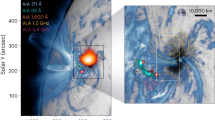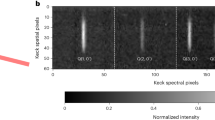Abstract
When Pioneers 10 and 11 flew by Jupiter, their 2.3-GHz monochromatic radio signals underwent substantial spectral broadening as they propagated through the planet's ionosphere1,2. Although spectral broadening has been observed during radio occultation by the solar corona3,4, the Pioneer measurements of Jupiter represent the first time it has been observed during radio occultation by a planetary atmosphere. The Pioneer data are also unique in that r.f. spectral broadening, a scattering phenomenon normally associated with strong intensity scintillations (σ2χ ∼ 1 where σ2χ is the variance of the log-amplitude scintillations), occurred when the intensity scintillations were weak. This unusual opportunity makes it possible to compare the theory for spectral broadening with the more widely used weak intensity scintillation theory5,6. We report here that good agreement is found, and present the inferred characteristics of the electron density irregularities for the ionospheres of both Jupiter and Saturn. The Saturn results are based on measurements made during the 1979 Pioneer 11 encounter of Saturn.
This is a preview of subscription content, access via your institution
Access options
Subscribe to this journal
Receive 51 print issues and online access
$199.00 per year
only $3.90 per issue
Buy this article
- Purchase on Springer Link
- Instant access to full article PDF
Prices may be subject to local taxes which are calculated during checkout
Similar content being viewed by others
References
Kliore, A. et al. Science 188, 474 (1975).
Fjeldbo, G., Kliore, A., Seidel, B., Sweetnam, D. & Cain, D. Astr. Astrophys. 39, 91 (1975).
Goldstein, R. M. Science 166, 598 (1969).
Woo, R. & Armstrong, J. W. J. geophys. Res. 84, 7288 (1979).
Tartarskii, V. I. The Effects of the Turbulent Atmosphere on Wave Propagation (National Technical Information Service, Springfield, 1971).
Ishimaru, A. Wave Propagation and Scattering in Random Media Vol. 2 (Academic, New York, 1978).
Woo, R. & Yang, F. C. J. Geophys, Res. 83, 5245 (1978).
Woo, R., Yang, F. C. & Ishimaru, A. Astrophys. J. 210, 593 (1976).
Woo, R., Yang, F. C. & Ishimaru, A. Astrophys. 218, 557 (1977).
Kliore, A. et al. Science 207, 446 (1980).
Fejer, B. G. & Kelley, M. C. Rev. Geophys. Space Phys. 18, 401 (1980).
Author information
Authors and Affiliations
Rights and permissions
About this article
Cite this article
Woo, R., Armstrong, J. Spectral broadening measurements of the ionospheres of Jupiter and Saturn. Nature 287, 309–311 (1980). https://doi.org/10.1038/287309a0
Received:
Accepted:
Published:
Issue Date:
DOI: https://doi.org/10.1038/287309a0
Comments
By submitting a comment you agree to abide by our Terms and Community Guidelines. If you find something abusive or that does not comply with our terms or guidelines please flag it as inappropriate.



